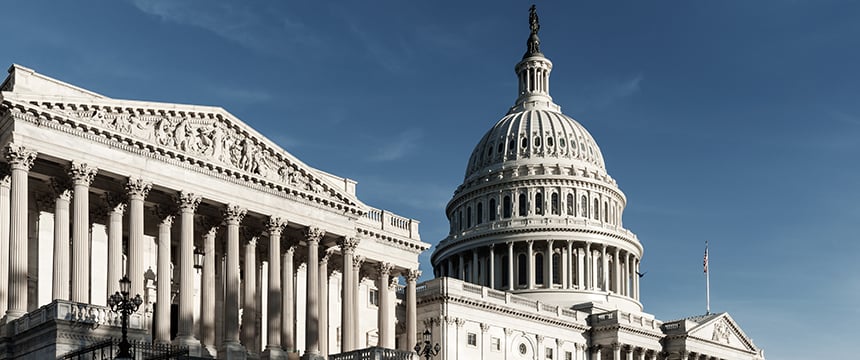
While Congress has a two-week recess in April, there are many priority items on the agenda this month. Less than two weeks after signing the Fiscal Year (FY) 2022 spending package, President Biden released his budget for FY 2023 on March 28th, 2022. Congress must negotiate and pass appropriations by September 30th, 2022 to avoid a government shutdown. Given the upcoming midterm elections, many think it is unlikely that they will pass anything more than a continuing resolution before December.
Other major issues consuming the congressional calendar in April include the Senate voting on Judge Ketanji Brown Jackson’s confirmation to the Supreme Court, Russia’s continued invasion of Ukraine, and the re-opening of Capitol Hill and the White House. With all of this and more, April is shaping up to be a busy month in Washington.
See below for greater detail regarding what’s coming in this month’s edition of What’s Next in Washington? presented by the Foley & Lardner Federal Public Affairs team.
1. President Biden released his budget in March
a. The White House released its FY 2023 budget proposal early this week. Congress will now begin the deliberation process on the budget. You can read the full document here.
b. Under the President’s proposal, Congress would allocate federal agencies $5.6 trillion, $1.6 trillion of which would be in discretionary funding.
i. Importantly, the proposal does not reflect the omnibus spending package passed in March 2022. As such, most funding increases are based on FY 2021 levels.
2. The House and Senate head to conference on competition legislation
a. The House and Senate have passed two different versions of economic competition legislation. The Senate passed the U.S. Innovation and Competition Act (USICA) in 2021, and the House passed the America COMPETES Act in February.
i. Both of these bills aim to bolster American manufacturing and increase American technological competitiveness with adversaries such as China.
b. The Senate passed an amended version of the America COMPETES Act on March 28th. House and Senate leadership are currently negotiating the structure of the conference to iron out the differences between the two bills in the Senate.
i. Negotiations on the bill could be lengthy due to the 50-50 split of the Senate and thin margins in the House.
ii. Proponents of the bill hope to have it passed by the end of the spring.
c. A key sticking point of the bill is the potential inclusion of the Facilitating American-Built Semiconductors (FABS) Act.
i. The FABS Act, which was originally introduced in the Senate and has garnered bipartisan and bicameral support, would create a 25% tax investment credit for investments in semiconductor manufacturing.
d. Increasing domestic manufacturing and improving American economic competitiveness on the global scale have been key aspects of the Biden Administration’s agenda. Democrats and President Biden hope to notch a bipartisan victory on this legislation prior to the November midterm elections.
3. Capitol Hill and the White House begin to reopen to the public
a. The Capitol complex has started opening in phases. It reopened to smaller groups and visitors on business in late March, with the intention of a full return to normal by the end of the summer.
i. The cap for visitors per group in the Capitol is now 15, rather than the previous limit of nine, which includes the limit for staff-led tours.
ii. The Capitol Visitor Center (CVC) is also slowly reopening to tourists with the intention of a full opening by Labor Day.
b. Within the last few months, House and Senate offices have started accommodating in-person meetings. Protocol for these meetings varies from office to office, including, for some, a limit on the number of visitors, proof of vaccination rate, and required check-in at restricted doorways. Other offices are still meeting virtually.
c. Public tours of the White House will resume on Fridays and Saturdays beginning April 15th, with the caveat that adjustments may need to be made based on COVID-19 cases.
d. House Speaker Nancy Pelosi (D-CA) announced at the end of March that the House will continue to allow Member proxy voting through May 14th.
4. Congress will hold multiple hearings on the current state of the energy industry
a. On April 1, President Biden announced that the Department of Energy will release one million barrels of oil per day for 180 days from the Strategic Petroleum Reserve to help lower domestic fuel prices. Biden also announced that the Administration will use the powers of the Defense Production Act to increase the production of key critical minerals necessary for battery production to spur additional renewable energy integration.
b. Congress is also taking action by calling in oil and gas companies to testify.
i. House Energy & Commerce Chairman Frank Pallone (D-NJ) has requested six oil and gas companies to appear before the committee on April 6th.
ii. This includes BP, Chevron, Devon Energy Corporation, ExxonMobil, Pioneer Natural Resources, and Royal Dutch Shell.
c. Rising gas prices have caused a partisan battle across the aisle. Democrats have placed the blame on oil companies, stating that they are price gouging.
i. The White House has joined in on this argument, pointing out the falling price of a barrel of oil, yet gas prices continue to rise.
d. Republicans have stated that the Biden Administration’s energy agenda has caused gas prices to surge, and the Russian invasion of Ukraine has only exacerbated the crisis.
e. Senator Maria Cantwell (D-WA), chair of the Senate Commerce, Science, & Transportation committee, has also requested oil executives to appear before Congress. The hearing is anticipated to occur in early April.
5. The Senate looks to confirm Judge Ketanji Brown Jackson to the Supreme Court
a. After a week of contentious hearings, Judge Ketanji Brown Jackson is expected to be confirmed to the Supreme Court this month.
b. Numerous Democrats, including Sen. Joe Manchin (D-WV), who has acted as the swing vote on various democratic proposals, have confirmed that they will vote for Jackson to be confirmed. Jackson would become the first African American woman on the Supreme Court.
i. Republican Senator Susan Collins (R-ME) announced that she will vote to confirm Jackson, marking the first Republican to cross the aisle in support of the confirmation. It is unknown if other Republican Senators will join in confirming Jackson.
c. Senate Judiciary Chair Dick Durbin (D-IL) has stated that the Judiciary committee will vote on Jackson on April 4th. Senate Democrats hope to have Jackson confirmed by April 9th.
6. Russia continues its invasion of Ukraine as peace talks unfold
a. As the Russian invasion of Ukraine enters its second month, there has been little progress on the side of the Russian army. Fierce Ukrainian resistance has nearly stopped the Russian advance.
b. Discussions have begun between Ukraine and Russia on a potential ceasefire. Turkey, a NATO member, has acted as an intermediary between the two countries.
i. Ukraine’s petition to join NATO has remained a major sticking point for Russia. Russian President Vladimir Putin has regarded any expansion of NATO as a direct threat to Russia.
c. Ukrainian President Volodymyr Zelensky has indicated that he is open to Ukrainian neutrality and abandoning joining NATO, but has called on Russia to remove its troops from the country first.
d. President Biden, in a speech in Warsaw, stated that President Putin “cannot remain in power”. President Biden and Secretary of State Antony Blinken have since walked back those comments by stating that the U.S. is not advocating for a regime change in Russia.
7. Possible action could occur on several pieces of health legislation and regulatory policy in April
a. User Fee Reauthorization:
i. User Fee programs for human prescription drugs and biologics, medical devices, and generic drugs and biosimilars that were last reauthorized under the FDA Reauthorization Act of 2017 are set to expire this year on October 1st, 2022 (each has five-year authorization periods).
ii. The Senate HELP Committee and the House Energy and Commerce Committee have begun holding hearings to discuss reauthorization legislation for the Prescription Drug User Fee Act (PDUFA), Generic Drug User Fee Amendments (GDUFA), Biosimilar User Fee Act (BsUFA), and Medical Device User Fee Amendments (MDUFA).
1. As this is a vital must-pass piece of legislation, Congress will likely include other priority regulatory policies as riders.
b. Mental Health:
i. Over the course of the last several months, relevant committees on both sides of Congress have held hearings to learn more about various mental health crises affecting Americans of all ages.
ii. Most recently, the Senate Health, Education, Labor and Pensions (HELP) Committee held a hearing focused on how the federal government can better support efforts to address mental health and substance use disorders. Committee leaders are working in a bipartisan fashion to develop more federal support for mental health services, including supporting suicide screening and prevention, helping schools and communities, reducing overdose deaths, getting more access for substance use disorder treatment, and addressing various barriers that make it hard for people to get access to care.
iii. Chairwoman Patty Murray (D-WA) said in her opening testimony at the hearing that she expects a draft package to be introduced by early this summer.
iv. Additionally, the House Energy and Commerce Committee and the HELP Committee are currently working to reauthorize several Substance Abuse and Mental Health Services Administration programs (SAMHSA) that will expire this fall.
v. The Senate Finance Committee (SFC) held their third hearing on mental health late last month, which focused on the lack of parity of treatment and insurance coverage that for mental health issues versus physical health care. Chairman Ron Wyden (D-OR) noted in his opening statement that the committee is working on a bipartisan basis to fix the parity law by breaking down the financial barriers of care that include “ghost networks,” coverage limits, coverage loopholes, and stonewalling on payment claims.
1. You can read the SFC’s recently-released report on this subject here.
c. Pandemic and ARPA-H:
i. Last month, the Senate HELP Committee voted 20-2 to report the PREVENT Pandemics Act (S.3799) favorably out of committee. The legislation includes authorizing language to establish the Advanced Research Project Authority for Health (ARPA-H), works to modernize various aspects of public health, including data collection, strengthening the domestic supply chain, and providing more accountability for the Center for Disease Control (CDC), among other things.
1. You can read more about it here.
ii. The bill now heads to the floor for consideration, with the intention of passing it before the end of the year.
iii. Other major biomedical innovation and pandemic preparedness bills in consideration currently include CURES 2.0 (H.R. 6000) and the ARPA-H Act (H.R. 5585) in the House.
1. Discrepancies remain over where to house ARPA-H, either within the National Institute for Health (NIH), or as its own separate entity.
d. Insulin Cap:
i. The House is voting on H.R. 6833 this week, a bill that would cap monthly insulin costs at $35 for people with insurance. It is expected to pass on a party line vote, without any Republican cosponsors.
ii. In the Senate, Sen. Susan Collins (R-ME) and Sen. Jeanne Shaheen (D-NH) are working on new bipartisan legislation to lower insulin costs. Sen. Raphael Warnock (D-GA) has not garnered enough support for his bill, S. 3700, which is the Senate companion to H.R. 6833.
iii. Majority Leader Chuck Schumer (D-NY) hopes to bring the measure to the floor for a vote following the two-week April recess.
e. PHE:
i. The Public Health Emergency is set to expire on April 16th, and Republican lawmakers are putting pressure on the Department of Health and Human Services (HHS) to lift it soon. HHS promised state and local officials a 60-day warning before ending it, so the emergency will likely be re-upped through at least July.
ii. Questions remain about many of the flexibilities that will end when it is lifted, including telehealth services, expedited authorization for COVID-19 treatments & vaccines, and access to Medicaid.
8. Community Project Funding guidelines and deadlines have been released, Members are now accepting applications
a. Community Project Funding (CPF) requests, known colloquially as earmarks, have been officially announced for FY2023.
i. Earmarks made their return to Congress for the first time in a decade last year. You can read a breakdown of the CPF request process and Foley’s efforts that resulted in significant funding for our clients here.
b. House Appropriations Chairwoman Rosa DeLauro (D-CT) outlined the guidelines for Member requests in late March.
i. Members can now submit up to 15 CPF requests; up from 10 last year.
c. The House Appropriations Committee has set the deadline for CPF requests to be reported by Members to the committee for the end of April.
d. Members may set their request deadlines much earlier; many deadlines are often in the first week of April.
i. Deadlines differ per office, check with your Member of Congress for their specific request deadline.
e. The Senate Appropriations Committee has also announced their CPF guidance.
i. The Senate Appropriations refers to CPF requests as “congressionally directed spending”. The Committee has set a cap of 1% of total discretionary spending on congressionally directed spending items.
f. The deadlines to report spending requests vary for each subcommittee and range throughout May.
i. Each Senate office may have a different deadline to submit a request, check with your Senator for their specific request deadline.



